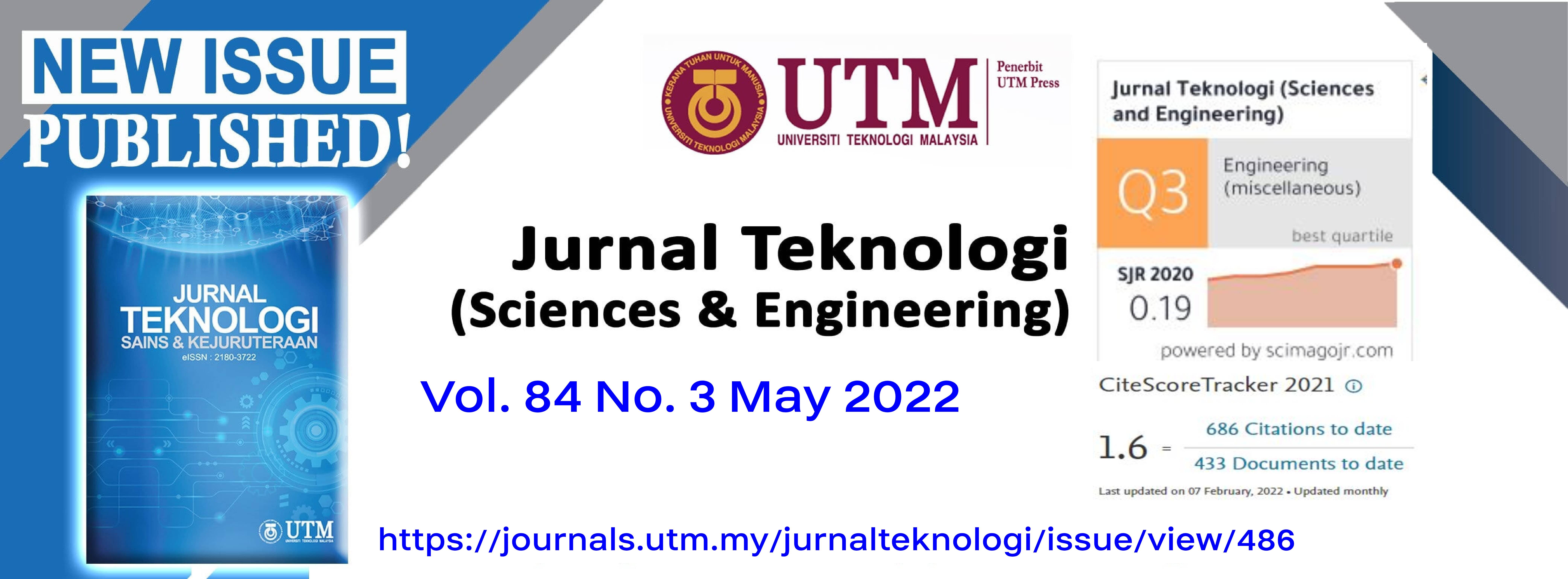OUTAGE PERFORMANCE OF COOPERATIVE RELAY PROTOCOL ON UAVS-BASED FLYING ADHOC NETWORK
DOI:
https://doi.org/10.11113/jurnalteknologi.v84.17552Keywords:
Data Dissemination, Cooperative Relaying, UAV Deployment Scenarios, System Outage Probability, Monte Carlo SimulationAbstract
Unmanned aerial vehicles (UAVs) are getting increased strength and count day by day in various civilian and military applications. The UAVs can form flying ad-hoc networks (FANET) to send data to a distant ground control station through multi-hop relaying. However, due to typical features of UAVs and limitations posed by areas of deployment, achieving efficient data dissemination with quality of service is a challenging task in such networks. Different algorithms have been reported in literature however, physical layer transmission issues need to be investigated more in such networks. In this work, we consider dual-hop cooperative communication using a single relay in a downlink communication scenario. A data dissemination scheme based on cooperative relaying is proposed to ensure reliability in operation. The performance of a non-buffer aided dual-hop relay network of UAVs considering the hardware impairments is analyzed. The end-to-end SNR analysis and derivation of the probability of outage expressions for both regenerative and non-regenerative modes of communication working in a half-duplexed fashion are presented. Monte Carlo Simulations verify the analytical results and depict that our proposed cooperative communication scheme improves the system performance compared to compulsory direct and compulsory indirect communication. The system achieves performance improvement at lower data rates using hardware without impairments working on Rayleigh fading channels in an urban environment. Results display that the fading distribution coefficients have a strong impact on system performance.
References
O. K. S. Ş. T. İlker Bekmezci. 2013. Flying Ad-Hoc Networks (FANETs): A Survey. Ad Hoc Networks. 11(3): 1254-1270.
A. Srivastava and J. Prakash. 2021. Future FANET with Application and Enabling Techniques: Anatomization and Sustainability Issues. Computer Science Review. 39.
C. J. Z. H. Y. R. R. G. M. a. L. H. J. Wang. 2017. Taking Drones to the Next Level: Cooperative Distributed Unmanned-Aerial-Vehicular Networks for Small and Mini Drones. IEEE Vehicular Technology Magazine. 12(3): 73-82.
E. Yanmaz, S. Hayat, J. Scherer and C. Bettstetter. 2014. Experimental Performance Analysis of Two-hop Aerial 802.11 Networks. IEEE Wireless Communications and Networking Conference (WCNC).
G. Karagiannidis. 2006. Performance Bounds of Multihop Wireless Communications with Blind Relays Over Generalized Fading Channels. IEEE Trans. Wireless Commun. 5(3): 4983-503.
G. Kramer, M. Gastpar and P. Gupta. 2005. Cooperative Strategies and Capacity Theorems for Relay Networks. IEEE Transactions on Information Theory. 51(9): 3037-3063.
M. Edrich and R. Schmalenberger. 2002. Combined DSSS/FHSS Approach to Interference Rejection and Navigation Support in UAV Communications and Control. IEEE 7th Int. Symp. on Spread Spectrum Techn. and App. Prague, Czech Republic.
M. N. Bashir and K. M. Yusof. 2019. Green Mesh Network of UAVs: A Survey of Energy Efficient Protocols across Physical, Data Link and Network Layers. 4th MEC International Conference on Big Data and Smart City (ICBDSC). Muscat Oman.
T. Cover and A. Gamal. 1979. Capacity Theorems for the Relay Channel. IEEE Transactions on Information Theory. 25(5): 572-584.
Y. Cao and V. Li. 2002. Utility-oriented Adaptive QoS and Bandwidth Allocation in Wireless Networks. IEEE International Conference on Communications. Anchorage, AK.
D. Deng, Y. Rao and F. Zhu. 2020. Impact of Hardware Impairments with Imperfect Channel Estimation for Cache-Enabled UAV Relaying Networks. Wireless Communications and Mobile Computing. 22020. Article ID 8891793.
G. Zhou, C. Pan, H. Ren, K. Wang and Z. Peng. 2021. Secure Wireless Communication in RIS-Aided MISO System with Hardware Impairments. IEEE Wireless Communications Letters.10(6): 1309-1313.
J. Hou, Z. Yang and M. Shikh-Bahaei. 2020. Hardware Impairment-aware Data Collection and Wireless Power Transfer using a MIMO Full-Duplex UAV. 2020 IEEE International Conference on Communications Workshops (ICC Workshops), Dublin, Ireland.
X. Li, Q. Wang, Y. Liu, T. A. Tsiftsis, Z. Ding and A. Nallanathan. 2020. UAV-Aided Multi-Way NOMA Networks With Residual Hardware Impairments. IEEE Wireless Communications Letters. 9(9): 1538-1542.
T. Zhang, G. Liu, H. Zhang, W. Kang, G. K. Karagiannidis and A. Nallanathan. 2020. Energy-efficient Resource Allocation and Trajectory Design for UAV Relaying Systems. IEEE Transactions on Communications. 68(10): 6483-6498.
T. Soithong, V. A. Aalo, G. P. Efthymoglou and C. Chayawan. 2012. Outage Analysis of Multihop Relay Systems in Interference-limited Nakagami- m Fading Channels. IEEE Transactions on Vehicular Technology. 61(3): 1451-1457.
Y. Dhungana, N. Rajatheva and C. Tellambura. 2012. Dual Hop MIMO OSTBC for LMS Communication. IEEE Wireless Commun. Lett. 1(2): 105-108.
M. O. Hasna and M. -.. Alouini. 2004. A Performance Study of Dual-hop Transmissions with Fixed Gain Relays. IEEE Transactions on Wireless Communications. 3(6): 1963-1968.
W. C. Jakes and D. Cox. 1974. Microwave Mobile Communications.
T. Schenk. 2008. RF Imperfections in High-Rate Wireless Systems: Impact and Digital Compensation. RF Imperfections in High-Rate Wireless Systems: Impact and Digital Compensation. Springer.
E. Bjornson, M. Matthaiou and M. Debbah. 2013. A New Look at Dual-hop Relaying: Performance Limits with Hardware Impairments. IEEE Transactions on Communications. 61(11): 4512-4525.
X. Yue, Y. Liu, S. Kang and A. Nallanathan. 2017. Performance Analysis of NOMA with Fixed Gain Relaying Over Nakagami-m Fading Channels. IEEE Access. 5: 5445- 5454.
B. Halima and N. B. 2019. Optimal Routing and One Hop Routing for D2D Communications in the Presence of Mutual Interference. Telecommun Systems. 71: 55-64,
A. U. Sheikh, M. Abdi and M. Handforth. 1993. Indoor Mobile Radio Channel at 946 MHz: Measurements and Modeling. IEEE 43rd Vehicular Technology Conference, Secaucus, NJ, USA.
D. Senaratne and C. Tellambura. 2010. Unified Exact Performance Analysis of Two-hop Amplify-and-Forward Relaying in Nakagami Fading. IEEE Transactions on Vehicular Technology. 59(3): 1529-1534.
Downloads
Published
Issue
Section
License
Copyright of articles that appear in Jurnal Teknologi belongs exclusively to Penerbit Universiti Teknologi Malaysia (Penerbit UTM Press). This copyright covers the rights to reproduce the article, including reprints, electronic reproductions, or any other reproductions of similar nature.
















